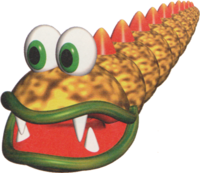Centipede: Difference between revisions
From the Super Mario Wiki, the Mario encyclopedia
Jump to navigationJump to search
LinkTheLefty (talk | contribs) (Better sources, since website is citing the start of a sentence.) |
LinkTheLefty (talk | contribs) No edit summary |
||
| Line 1: | Line 1: | ||
[[File:CentipedeYSArtwork.png|thumb|200px|Artwork of a centipede]] | [[File:CentipedeYSArtwork.png|thumb|200px|Artwork of a centipede]] | ||
[[File:Centipede.png|thumb|left|A centipede as it appears in ''[[Yoshi's Story]]'']] | [[File:Centipede.png|thumb|left|A centipede as it appears in ''[[Yoshi's Story]]'']] | ||
'''Centipedes'''<ref>Leung, Jason, Terry Munson, and Scott Pelland. ''Yoshi's Story'' Player's Guide. Pages 10, 70, 71.</ref><ref>Prima Bath. ''Nintendo 64 Game Secrets, 1999 Edition'' Prima's Official Strategy Guide. Page 109.</ref>, also called '''snakes'''<ref>Prima Bath. ''Ultimate Nintendo 64 Pocket Power Guide, 1999 Edition'' Prima's Official Strategy Guide. Page 88. "''Finally, look for a snake with a question mark ball above it and collect the last special heart that’s inside.''"</ref>, are giant yellow monsters that pace back and forth atop the mountains in the Level 3-4: [[Frustration]] in ''[[Yoshi's Story]]''. They have sixteen segments (counting the head) with a pink spike on every segment except the head. They are invincible, and sometimes take a new path when there is a fork in the road. | '''Centipedes'''<ref>Leung, Jason, Terry Munson, and Scott Pelland. ''Yoshi's Story'' Player's Guide. Pages 10, 70, 71.</ref><ref>[https://web.archive.org/web/20000511100942/http://www.yoshisstory.com/page3-4.html ''Yoshi's Story'' official website (Wayback Archive)]. Retrieved April 30, 2020.</ref><ref>Prima Bath. ''Nintendo 64 Game Secrets, 1999 Edition'' Prima's Official Strategy Guide. Page 109.</ref>, also called '''snakes'''<ref>Prima Bath. ''Ultimate Nintendo 64 Pocket Power Guide, 1999 Edition'' Prima's Official Strategy Guide. Page 88. "''Finally, look for a snake with a question mark ball above it and collect the last special heart that’s inside.''"</ref>, are giant yellow monsters that pace back and forth atop the mountains in the Level 3-4: [[Frustration]] in ''[[Yoshi's Story]]''. They have sixteen segments (counting the head) with a pink spike on every segment except the head. They are invincible, and sometimes take a new path when there is a fork in the road. | ||
{{br|left}} | {{br|left}} | ||
==Names in other languages== | ==Names in other languages== | ||
{{foreign names | {{foreign names | ||
|Jap=ムカデ | |Jap=ムカデ<ref>[[Media:Yoshi Story Shogakukan P5.jpg|「ヨッシーストーリー 任天堂公式ガイドブック」 (''Yoshi's Story Nintendo Kōshiki Guidebook''), page 5.]]</ref> | ||
|JapR=Mukade | |JapR=Mukade | ||
|JapM=Centipede | |JapM=Centipede | ||
Revision as of 09:06, April 30, 2020
A centipede as it appears in Yoshi's Story
Centipedes[1][2][3], also called snakes[4], are giant yellow monsters that pace back and forth atop the mountains in the Level 3-4: Frustration in Yoshi's Story. They have sixteen segments (counting the head) with a pink spike on every segment except the head. They are invincible, and sometimes take a new path when there is a fork in the road.
Names in other languages
| Language | Name | Meaning |
|---|---|---|
| Japanese | ムカデ[5] Mukade |
Centipede |
| German | Dingelchen Wurm[citation needed] |
Little thing worm |
References
- ^ Leung, Jason, Terry Munson, and Scott Pelland. Yoshi's Story Player's Guide. Pages 10, 70, 71.
- ^ Yoshi's Story official website (Wayback Archive). Retrieved April 30, 2020.
- ^ Prima Bath. Nintendo 64 Game Secrets, 1999 Edition Prima's Official Strategy Guide. Page 109.
- ^ Prima Bath. Ultimate Nintendo 64 Pocket Power Guide, 1999 Edition Prima's Official Strategy Guide. Page 88. "Finally, look for a snake with a question mark ball above it and collect the last special heart that’s inside."
- ^ 「ヨッシーストーリー 任天堂公式ガイドブック」 (Yoshi's Story Nintendo Kōshiki Guidebook), page 5.
